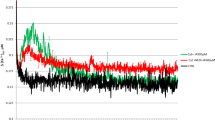Abstract
Methyl jasmonate and jasmonate isomers were resolved for studies in stereoselectivity of biological action. Chemical modifications included fluorination at the chiral C7 carbon, trifluorination at the C12 of the pentenyl sidechain, shortening of this pentenyl to a butenyl moiety, and synthesis of the (+) and (–)-epi-methyl jasmonates. The effects of these modifications and stereospecificity were monitored using three assays: proteinase inhibitor II promoter driving the reporter β-glucuronidase; endogenous trypsin proteinase inhibitor induction; and sunflower cotyledon senescence induction. The methyl esters were more active than the corresponding acids, the R absolute configuration at C3 was most effective in all assays, fluorination at C7 abolished activity in the proteinase inhibitor assays, and the trifluorination at C12 or shortening to a butenyl did not alter activity relative to the active (–)- methyl jasmonate, but both of these latter modifications revealed a delayed response in the senescence conductivity measures.
Similar content being viewed by others
References
Bleeker AB and Patterson SE (1997) Last exit: Senescence, abscission, and meristem arrest in Arabidopsis. Plant Cell 9: 1169–1179
Bolter CJ and Jongsma MA (1995) Colorado potato beetles (Leptinotarsa decemlineata) adapt to proteinase inhibitors induced in potato leaves by methyl jasmonate. J Insect Physiol 41: 1071–1078
Botella MA, Xu Y, Prabha TN, Zhao Y, Narasimhan ML, Wilson KA, Nielsen SS, Bressan RA and Hasegawa PM (1996) Differential expression of soybean cysteine proteinase inhibitor genes during development and in response to wounding and methyl jasmonate. Plant Physiol 112: 1201–1210
Bradford MM (1976) A rapid and sensitive method for the quantitation of microgram quantities of protein utilizing the principle of protein-dye binding. Anal Biochem 72: 248–254
Buchanan-Wollaston V (1997) The molecular biology of leaf senescence. J Exptl Bot 48: 181–199
Creelman RA, Tierney ML and Mullet JE (1992) Jasmonic acid/methyl jasmonate accumulate in wounded soybean hypocotyls and modulate wound gene expression. Proc Natl Acad Sci USA 89: 4938–4941
Creelman RA and Mullet JE (1997a) Oligosaccharins, brassinolides, and jasmonates: Nontraditional regulators of plant growth, development and gene expression. Plant Cell 9: 1211–1223
Creelman RA and Mullet JE (1997b) Biosynthesis and action of jasmonates in plants. Ann Rev Plant Physiol Plant Mol Biol 48: 355–381
Emery RJN and Reid DM (1996) Effects of methyl jasmonate on ethylene synthesis and organ-specific senescence in Helianthus annuus seedlings. Plant Growth Regul 18: 213–222
Engvild KC (1989) The death hormone hypothesis. Physiol Plant 77: 282-285
Farmer EE and Ryan CA (1990) Interplant communication: airborne methyl jasmonate induces synthesis of proteinase inhibitors in plant leaves. Proc Natl Acad Sci USA 87: 7713–7716
Farmer EE and Ryan CA (1992) Octadecanoid precursors of jasmonic acid activate the synthesis of wound-inducible proteinase inhibitors. The Plant Cell 4: 129–134
Farmer EE, Johnson RR and Ryan CA (1992) Regulation of expression of proteinase inhibitor genes by methyl jasmonate and jasmonic acid. Plant Physiol 98: 995–1002
Hildmann T, Ebneth M, Pena-Cortes H, Sanchez-Serrano JJ, Willmitzer L and Prat S (1992) General roles of abscisic and jasmonic acids in gene activation as a result of mechanical wounding. The Plant Cell 4: 1157–1170
Holbrook LA, Tung P, Ward K, Reid DM, Abrams S, Lamb N, Quail JW and Moloney MM (1997) Importance of the chiral centres of jasmonic acid in the responses of plants: Activities and antagonism between natural and synthetic analogues. Plant Physiol 114: 419–428
Kiyota H, Saitoh M, Oritani T and Yoshihara T (1996) Synthesis and Potato Tuber-inducing activity of methyl 5'5'5'-trifluorojasmonate. Phytochemistry 42: 1259–1262
Koda Y (1992) The role of jasmonic acid and related compounds in the regulation of plant development. Int Rev Cytol 135: 155–199
Koda Y, Kikuta Y, Kitahara T, Nishi T and Mori K (1992) Comparisons of various biological activities of stereoisomers of methyl jasmonate. Phytochemistry 31: 1111–1114
Koda Y, Ward JL and Beale MH (1995) Biological activity of methyl 7-methyl-jasmonates. Phytochemistry 38: 347–350
Mason HS, DeWald DB, Creelman RA and Mullet JE (1992) Coregulation of soybean vegetative storage protein gene expression by methyl jasmonate and soluble sugars. Plant Physiol 98: 859–867
Martin C and Glover B (1997) Turning over new leaves. Trends in Plant Sci 2: 330–331
Miersch O, Meyer A, Vorkefeld S and Sembdner G (1986) Occurrence of (+)-7-iso-jasmonic acid in Vicia faba L. and its biological activity. J Plant Growth Regul 5: 91–100
Mueller MJ and Brodschelm W (1994) Quantification of jasmonic acid by capillary gas chromatography-negative chemical ionization-mass spectrometry. Anal Biochem 218: 425–435
Nojiri H, Sugimori M, Yamane H, Nishimura Y, Yamada A, Shibuya N, Kodama O, Murofushi N and Omori T (1996) Involvement of jasmonic acid in elicitor-induced phytoalexin production in suspension-cultured rice cells. Plant Physiol 110: 387–392
Parthier B, Bruckner C, Dathe W, Hause B, Herrmann G, Knofel HD, Kramell HM, Kramell R, Lehmann J, Miersch O, Reinbothe ST, Sembdner G, Wasternack C and Zur Nieden U (1992). Jasmonates: Metabolism, biological activities, and modes of action in senescence and stress responses. In: Karssen CM, Van Loon LC and Vreugdenhil D (eds) Progress in Plant Growth Regulation. Dordrecht: Kluwer Academic Publishers, pp 276–285
Pena-Cortes H, Albrecht T, Prat S, Weiler EW and Willmitzer L (1993) Aspirin prevents wound-induced gene expression in tomato leaves by blocking jasmonic acid biosynthesis. Planta 191: 123–128
Reinbothe S, Mollenhauer B and Reinbothe C (1994) JIPs and RIPs: the regulation of plant gene expression by jasmonates in response to environmental cues and pathogens. Plant Cell 6: 1197–1209
Rymerson RT and Bodnaryk RP (1995) Gut proteinase activity in insect pests of canola. The Canadian Entomologist 127: 41–48
Sembdner G, Meyer A, Miersch O and Bruckner C (1988) Metabolism of Jasmonic Acid. In: Pharis RP and Rood SB (eds) Plant Growth Substances. Berlin: Springer-Verlag, pp 374–379
Taapken T, Bleckert S, Weiler EW and Zenk MH (1994) Stereoselective synthesis of 7-substituted jasmonic acid derivatives and investigation of their biological activity. J Chem Soc Perkin Trans 1: 1439–1442
Ueda J and Kato J (1980) Isolation and identification of a senescence-promoting substance from wormwood (Artemesia absinthium L.). Plant Physiol 66: 246–249
Ueda J, Kato J, Yamane H and Takahashi N (1981) Inhibitory effect of methyl jasmonate and its related compounds on kinetin-induced retardation of oat leaf senescence. Physiol Plant 52: 305–309
Ueda J and Kato J (1982) Inhibition of cytokinin-induced plant growth by jasmonic acid and its methyl ester. Physiol Plant 54: 249–252
Wilen RW, van Rooijen GJH, Pearce DW, Pharis RP, Holbrook LA and Moloney MM (1991) Effects of jasmonic acid on embryo-specific processes in Brassica and Linum oilseeds. Plant Physiol 95: 399–405
Xu Y, Chang P-FL, Liu D, Narasimhan ML, Raghothama KG, Hasegawa PM and Bressan RA (1994) Plant defense genes are synergistically induced by ethylene and methyl jasmonate. The Plant Cell 6: 1077–1085
Yamane H, Sugawara J, Suzuki Y, Shimamura E and Takahashi N (1980). Syntheses of jasmonic acid related compounds and their structure-activity relationships on the growth of rice seedlings. Agric Biol Chem 44: 2857–2864
Author information
Authors and Affiliations
Rights and permissions
About this article
Cite this article
Ward, K., Tung, P., Lamb, N. et al. Structural requirements for biologically active jasmonates: Induction of protease inhibitors and cotyledon senescence. Plant Growth Regulation 27, 49–56 (1999). https://doi.org/10.1023/A:1006188418523
Issue Date:
DOI: https://doi.org/10.1023/A:1006188418523




